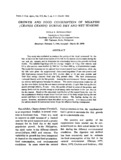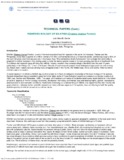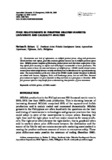Growth and food consumption of milkfish (Chanos chanos) during dry and wet seasons
Share
Abstract
This study was conducted to evaluate the quality of the food consumed by the fish, to estimate the food consumption of the fish in the natural environment during the wet and dry seasons, and to determine the relationship between the growth and food intake. The milkfish fingerlings with the average weights of 4.0 g (wet season) and 9.0 g (dry season) were stocked @ 700 ha-1 in three 1000 sq. m brackishwater ponds. The unfed fish depended on the natural food alone (natural food treatment), while the fed fish were given the supplemental diets containing either 25 per cent protein and 3031 Kcal energy (natural food plus 25% protein diet) or 36 per cent protein and 3344 Kcal energy (natural food plus 36% protein diet). The food consumption increased linearly with the fish growth. Among the environmental factors measured, the salinity varied greatly between the seasons. The caloric and protein intakes for all the fish were higher during the wet season (average salinity, 22 ppt) than during the dry season (average salinity, 36 ppt). Also, the quality of food in terms of the protein and energy levels and the protein energy to total energy ratio was better in the wet than in the dry season. Based on the estimated contribution of the natural food, the rate for the supplemental feeding ranged from 2 to 4 per cent for the body weight during the wet season and from 1 to 2 per cent during the dry season. The feeding during the dry season, however, appeared to have less effect on the growth. It is recommended that the salinity should be maintained below 36 ppt for effective feeding management.
Suggested Citation
Sumagaysay, N. S. (1994). Growth and food consumption of milkfish (Chanos chanos) during dry and wet seasons. International Journal of Tropical Agriculture , 12(1), 1-11. http://hdl.handle.net/10862/1463
Subject
Taxonomic term
Collections
- AQD Journal Articles [1249]
Related items
Showing items related by title, author, creator and subject.
-
Fisheries biology of milkfish (Chanos chanos Forskal)
Garcia, Luis Maria (Food and Agriculture Organization of the United Nations, South Pacific Aquaculture Development Project, 1990)Milkfish (Chanos chanos Forskal) is one of the most important food fish species in the world. In Indonesia, Taiwan and the Philippines, more than a quarter of a million tonnes of milkfish are harvested annually in brackish ... -
Qualitative analysis of the contents of the anterior portion of the oesophagus from adult milkfish, Chanos chanos, captured in Pandan Bay from 10 May-June 1975
Villaluz, Antonio C.; Tiro, Leonardo B.; Ver, Leo M.; Vanstone, William E. (Aquaculture Department, Southeast Asian Fisheries Development Center, 1976)Qualitative analysis of food items in the anterior spiral portion of the oesophagus suggests that adult milkfish feed on both benthic and planktonic materials. -
Price relationships in Philippine milkfish markets: Univariate and causality analysis
Salayo, Nerissa D. (International Association of Aquaculture Economics and Management (IAAEM), 2006)Uncertainties and lack of information on milkfish product prices, along with production-related problems with inputs, generally constrain efficient resource use in milkfish grow-out operations. Milkfish growers complain ...




